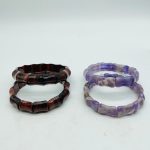Introduction
Rutile is a rare and valuable mineral that has a wide range of applications in various industries, including electronics, aerospace, and construction. This livre blanc provides a comprehensive overview of rutile, its properties, applications, and market dynamics.

Properties of Rutile
Rutile is a titanium oxide mineral with the chemical formula TiO2. It is a hard, brittle mineral with a high melting point and a high refractive index. Rutile is typically found in igneous and metamorphic rocks.
Physical Properties
- Hardness: 6-6.5 on the Mohs scale
- Specific gravity: 4.2-4.3
- Melting point: 1843°C (3349°F)
- Refractive index: 2.61-2.90
Chemical Properties
- Chemical formula: TiO2
- Insoluble in water
- Soluble in acids
Applications of Rutile
Rutile has a wide range of applications in various industries:
Electronics
- Capacitors: Rutile is used as the dielectric material in ceramic capacitors due to its high dielectric constant.
- Transistors: Rutile is used in the production of transistors as a gate oxide.
Aerospace
- Refractory materials: Rutile is used in the production of refractory materials for high-temperature applications.
- Rocket nozzles: Rutile is used as a coating for rocket nozzles to protect them from erosion.
Construction
- White pigments: Rutile is used as a white pigment in paints and coatings.
- Glass: Rutile is used in the production of glass to improve its strength and clarity.
Market Dynamics
The global rutile market is expected to grow significantly in the coming years due to increasing demand from the electronics industry. The major producers of rutile are Australia, South Africa, and China.
Key Market Drivers
- Growing demand from the electronics industry: The increasing demand for electronic devices is driving the demand for rutile.
- Rising construction activity: The growing construction industry is also contributing to the demand for rutile.
Challenges
- Depletion of high-grade rutile reserves: The depletion of high-grade rutile reserves is a major challenge facing the industry.
- Environmental concerns: The mining and processing of rutile can have negative environmental impacts.
Rutile Innovations
Researchers and companies are continuously exploring new and innovative applications for rutile. These include:
- Supercapacitors: Rutile is being investigated as a potential material for supercapacitors, which are energy storage devices with high power density.
- Solar cells: Rutile nanostructures are being developed for use in solar cells to improve their efficiency.
- Biomedical applications: Rutile nanoparticles are being investigated for use in biomedical applications, such as drug delivery and imaging.
Table 1: Physical Properties of Rutile
| Property | Value |
|---|---|
| Hardness | 6-6.5 |
| Specific gravity | 4.2-4.3 |
| Melting point | 1843°C (3349°F) |
| Refractive index | 2.61-2.90 |
Table 2: Chemical Properties of Rutile
| Property | Value |
|---|---|
| Chemical formula | TiO2 |
| Insoluble in water | Yes |
| Soluble in acids | Yes |
Table 3: Applications of Rutile
| Industry | Application |
|---|---|
| Electronics | Capacitors, transistors |
| Aerospace | Refractory materials, rocket nozzles |
| Construction | White pigments, glass |
Table 4: Key Market Drivers for Rutile
| Driver | Description |
|---|---|
| Growing demand from the electronics industry | The increasing demand for electronic devices is driving the demand for rutile. |
| Rising construction activity | The growing construction industry is also contributing to the demand for rutile. |
Pain Points and Motivations
Pain Points
- High cost of production
- Depletion of high-grade rutile reserves
- Environmental concerns
Motivations
- Growing demand for rutile
- Potential for new and innovative applications
- Sustainable mining and processing practices
Pros and Cons of Rutile
Pros
- High dielectric constant
- High refractive index
- High melting point
- Wide range of applications
Cons
- High cost of production
- Depletion of high-grade rutile reserves
- Environmental concerns
FAQs
1. What is rutile?
Rutile is a rare and valuable mineral with the chemical formula TiO2.
2. What are the properties of rutile?
Rutile is a hard, brittle mineral with a high melting point and a high refractive index.
3. What are the applications of rutile?
Rutile has a wide range of applications in the electronics, aerospace, and construction industries.
4. What are the key market drivers for rutile?
The key market drivers for rutile are the growing demand from the electronics industry and the rising construction activity.
5. What are the pain points and motivations in the rutile industry?
The pain points in the rutile industry include the high cost of production, the depletion of high-grade rutile reserves, and the environmental concerns. The motivations in the rutile industry include the growing demand for rutile, the potential for new and innovative applications, and the development of sustainable mining and processing practices.
6. What are the pros and cons of rutile?
The pros of rutile include its high dielectric constant, high refractive index, high melting point, and wide range of applications. The cons of rutile include its high cost of production, the depletion of high-grade rutile reserves, and the environmental concerns.




























